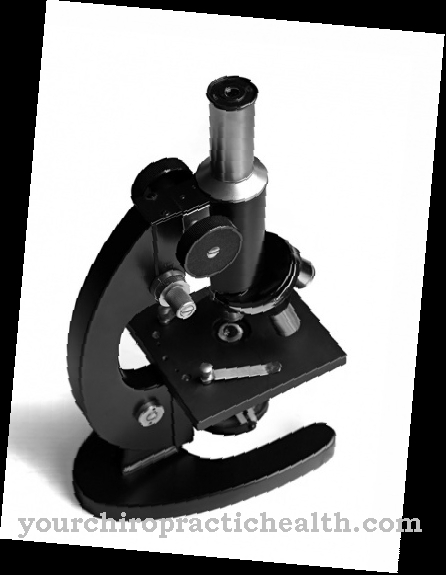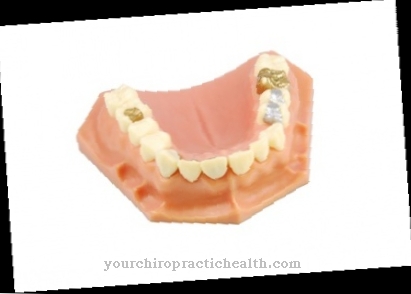As prosthesis is an organ or limb replacement through products that function similarly and were created artificially.
What is a prosthesis?
The first prostheses existed as early as the 20th century BC. BC, which were found in Egypt. In the Middle Ages, the so-called Iron Hands emerged, the principle of which was retained until the 18th century.
The first movable arm prostheses were invented by the dentist Peter Baliff and Margarethe Caroline Eichler. Today, with the help of microprocess-controlled leg or arm prostheses, very complex movements can be carried out and it is also possible to do sports with them.
Shapes, types & types

A lower leg prosthesis is a leg prosthesis that is used after an amputation of the leg below the knee joint.
If the prosthesis is found outside the human body, it is called an exoprosthesis. These include, for example, hand, arm or leg prostheses.
The prostheses of the lower extremities are divided into: foot prostheses, lower leg prostheses and thigh prostheses that are used after amputations as well as full-leg prostheses for hemipelvectomies or hip disarticulations. The upper limb prostheses are divided into forearm and upper arm prostheses.
A closed implant is called an endoprosthesis. This is completely surrounded by tissue, a typical example of which is the artificial hip joint. Endoprostheses partially or completely replace a joint and remain in the body permanently. The endoprostheses also include vascular replacements, heart valve replacements and breast implants.
An endoprosthesis is precisely fitted into the bone bed, whereby a distinction can be made between cemented prostheses, hybrid prostheses and cementless prostheses. If there are signs of wear and tear on the shoulder socket or the humerus head, a part can be replaced, in which case we speak of a hemiprosthesis. In contrast, there is the full denture or "Total Shoulder", in which the socket and the humerus head are replaced. Another form of shoulder prosthesis is the so-called surface replacement, which is also known as a cup prosthesis.
A so-called open implant is anchored in a bone, but is also visible outside. These include dental implants or implants that are used to attach prosthetic legs or auricle imitations. There are also many different types of dentures. They are removable, but there are also combinations that are partly fixed and partly removable. The removable dentures include full or total dentures or model cast dentures.
Structure & functionality
Arm prostheses that have a gripping function are mostly made of PVC, a material that is very robust and more similar to the skin than, for example, leather or wood. A negative effect of PVC outer skins is that they get dirty relatively easily, because after about three to four months the plastic discolors and then has to be changed.
As an alternative, cosmetic gloves made of silicone are also offered, which do not discolour and are also dirt-repellent. However, there is a risk that they will tear. In addition, they are much more expensive and their abrasion is also very strong. There are also silicone gloves available with nylon streaking through them. These have a shelf life of around six months, but cost significantly more than PVC gloves.
For lower limb prostheses, polished foam is often used, which is covered with a cosmetic stocking. With the help of a knee prosthesis, the worn part of a knee joint is replaced. A knee prosthesis consists of at least two different parts: a shin part and a thigh part. The thigh part is usually made of a cobalt-chromium alloy, while the shin part consists of a metal component with a plastic layer. Very hard plastic is used for the kneecap portion, but the replacement of this rear surface is not absolutely necessary, while the other two components have to be replaced regularly. However, the everyday life of the respective patient must also be taken into account, as the prosthesis is exposed to different loads.

A prosthesis socket for a replacement of the upper or lower extremity is always made individually, with a plaster cast usually serving as the basis. The shaft of a hip prosthesis is usually made of titanium alloys, CoCrMo forged alloys and, in individual cases, of fiber-reinforced plastics.
In the case of shoulder prostheses, it is very important that the different sizes and angles of the shoulder socket and the humerus head are exactly restored. In the case of dental prostheses, the model cast prostheses are composed of plastic parts or a metal frame. This type of prosthesis is relatively inexpensive and also gentle on the teeth, since the remaining teeth do not have to be ground. An aesthetic disadvantage, however, is that the brackets are often visible. These partial dentures can also be expanded and they are also suitable for people in whom further tooth loss is foreseeable.
Patients who no longer have teeth are given a full denture. This consists of a plastic base into which the plastic teeth are then inserted. The biggest problem with these prostheses is adhesion. Maxillary prostheses usually adhere better because they have a larger contact area, while the contact area in the lower jaw is smaller and this type of prosthesis is also less stable. In many cases the adhesion is improved by using a denture adhesive.
You can find your medication here
➔ Medicines for painMedical & health benefits
With the help of prostheses, parts of the body that no longer fulfill their function for a wide variety of reasons are replaced so that the users can retain their independence as much as possible. Initially, prostheses were only very primitive aids, but in recent years they have become extremely powerful, so that, for example, sports can be done with prosthetic legs. Dental prostheses are now also made of such high quality that often no difference to real teeth is noticed and the perfect fit guarantees the highest possible wearing comfort.



























